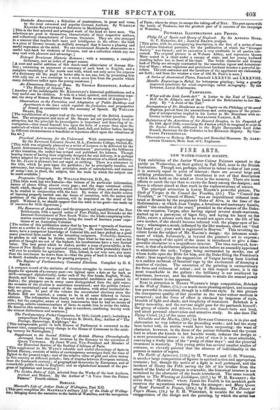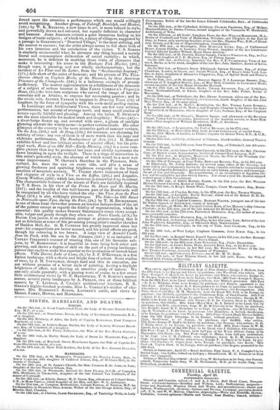FINE ARTS.
NEW WATER-COLOUR SOCIETY.
THE exhibition of the Junior Water-Colour Painters opened to the public on Wednesday, at their gallery in Pall Mall, next to the British Institution. Though not, perhaps, inferior in talent to that of last year, it is scarcely equal in point of interest : there are several large and striking productions, but their excellence is not of that description which takes hold on the mind or lives in the memory. There are more efforts to catch the eye than to excite the fancy among the designs ; and force is oftener aimed at than truth in the representations of nature.
The principal attraction is Lours Flacas's powerful picture, The Oath of Vargas in the Conseil des Troubles, (60.) The " Conseil des Troubles," er "Council of Blood," was an inquisitional tribunal bud. tilted at Brussels by the sanguinary Duke of Alva, in the time of the Reformation ; at which Jean Vargas, a ferocious and mercenary fanatic, called "the cruellest of the cruel," presided in the absence of the Duke. On one occasion, Vargas, after having signed several death-warrants, started up in a paroxysm of bigot fury, and laying his hand on the Bible, swore a solemn oath that he would not spare even the life of his own mother, if she should become infected with the plague-spot of he- resy; whereupon a monk, inflamed by the like madness, cried out "God has heard you; your oath is registered in Heaven." This revolting in- cident forms the subject of Mr. Haortz's design : the inhuman senti- ment of whioh, fortunately, is beyond the painter's art to explain; though enough of the spirit of the scene is introduced to give a din, greeable character to a magnificent interior. The idea conveyed, how- ever, is that of a deliberate adjuration taken before an assembly appointed to administer the oath ; Vargas being surrounded by monks, one of whom holds open the Bible for him, and the Duke filling the President'S chair ; thus negativing the supposition of Vargas having been kindled to a sudden outbreak of fanatical rage by the excitement of dooming a number of victims. The execution of the painting is extraordinary for force and richness of colour ; and in this respect alone, it is the most remarkable in the gallery : the brilliancy is not unalloyed by heaviness, however, and the determination to attain the utmost power of water-colours is too apparent.
Next in attraction is HENRY WARREN'S large composition, .Rebehah at the Well of Nahor, (75,)—a much more pleasing subject, and scarcely less powerful in execution, though in a different style. In this picture the transparent quality of tint peculiar to the water-colour medium is preserved ; and the force of effect is obtained by largeness of style, breadth of light and shade, and simplicity of treatment. Rebekah is a pretty nonentity, and the servant might pass for the patriarch himself: the group of camels and drivers, however, are desert-born and bred, and attest personal observation and attentive study. So also does .The Dying Camel, (4,) of the same artist. ,Grisdda and the Mar/sic, (2300 by EDWARD Consortia), is in size and elaboration no way inferior to the preceding works ; and had the story been better told, its merits would have been surpassing: the want of character, however, in the faces of the patient Griselda and the tyrant lord to whom she kneels in her humble weeds, reduces the design to a mere processional scene : in this point of view it is most admirable, conveying a lively idea of the "pomp of elder days"; and the pictorial treatment is masterly. This young artist has several smaller studies of costume, so cleverly painted that the absence of individuality in the persons is matter of regret. The Battle of Agincourt, (156,) by H. WARREN and C. H. WEIGILL, is another large composition of figures in spirited action and appropriate costume ; but, though the melee of a fight is well portrayed, and the incident of Henry the Fifth saving the life of his brother from the attack of the Duke of Alencon is traceable, the historical interest is not sustained by the character of the heads introduced. The same remark applies to The Warning at Linlithgow, (MO by W. II. KEARNEY ; the scene from " Marmion," where James the Fourth in his monkish garb receives the mysterious warning from the stranger ; and Mary Queen of Scots' Farewell to France, (214,) by F. Romani). The Dinner fit Page's House, (19,) by E. H. WEHNERT, is notable for the vulgar exaggeration of the design and the painting, by which the Artist hnS forced upon the attention a performance which one would willingly avoid recognizing. Another group, of Falstaff, Bard°lph, and Hostess, (180,) by W. K. KEELING, a new name in art, is more refined in style, and powerfully drawn and coloured, but equally deficient in character and humour. Joan AlisoLox evinces a quiet humorous feeling in his designs of rustic subjects ; of which 96, a dance of villagers, suggested by a passage in GOLDSMITH'S "Deserted Village," is the most striking, and the nearest to success ; but the artist always seems to fall short both of his own intention and the satisfaction of the visiter. T. S. Rowers is similarly unsuccessful when he attempts any thing beyond a merely literal and commonplace delineation of actual rusticity ; in which, moreover, he is deficient in marking those traits of character that make it interesting : his scene in the Boulogne Fish Market, (291,) though tame, is pleasing, and not wholly uncharacteristic; but the incident of La Fleur and the Letter, from the "Sentimental Journey," (I71,) falls short of the point of humour; and his picture of The Trea- cherous Attack on Captain Broke, of the Shannon, by three American Prisoners of the Chesapeake, (2460 is a ludicrous example of prosaic inefficiency. The nearest approximation to a fulfilment of the demands of a subject of serious interest is Miss FANNY CORBAUX'S Properria .Rossi, (65,) the love-lorn sculptress who carved the image of her dis- consolate self as Ariadne, to express her consuming passion ; and in the comic vein, ALFRED TAYLOR is happiest in Drawing Tears (82) of laughter, by the force of sympathy with his cook-maid peeling onions.
In Landscape and Architectural Views, there are few very striking performances, but several of average merit, and many small studies of nature equally faithful and pleasing. Among the latter, E. Dutecate's are the most admirable for modest truth and simplicity : Winter, (41)- a river-barge frozen up, and covered with snow, a gleam of sunlight glancing athwart the wintry scene—is perfect verisimilitude. His other glimpses of the country in the more attractive garb of summer verdure, On the Lea, (208,) and At Bray, (132,) for instance, are charming for sobriety of tone : any one of them is of more worth than his large and elaborate performance, The Bombardment of Acre, (91.) H. BRIGHT exhibits fewer and less brilliant studies of natural effect; but his prin- cipal work, Ruin of an Old Mill—Early Morning, 040 is a more com- plete picture than any he produced last year, and vividly represents the dawn breaking in upon the twilight. There is a tinge of mannerism in this artist's powerful style, the absence of which would be a most wel- come improvement. W. OLIVER'S Sketches in the Pyrenees, Swit- zerland, &c. meet the eye on every side, and give a sense of glowing freshness and sparkling brightness congenial to the breezy sunshine of mountain scenery. W. nuns shows indications of force and elegance of style in a View on the Liffey, (2660 and Luggelan, County Wicklow, (203); which last, however, is somewhat foxy in colour. The characteristic features of the streets of Paris are faithfully depicted by T. S. BOYS, in his view of the Portes St. Denis and St. Martin, (257); and the locality of this well-known part of the Boulevards will be recognized by all who have visited the city : his View from the Pont Neuf, (278,) is also strikingly picturesque. The Side—an Old Street in Newcastle-upon-Tyne, during the Fair, (24,) by T. M. RICHARDSON, is one of those local views that possess an interest independent of the art of the painter except as regards the fidelity of representation, which is essential : this quality makes SYDNEY SHEPHERD'S street views accept- able, vulgar and gaudy though they often are. Powis Castle, (MO by Davin Cox junior, is an ambitious attempt at picture-making that is not so felicitous as some of this promising young artist's smaller sketches of Haddon Hall, &c. G. B. CAMPION has greatly improved since last year; his compositions are better massed, and his aerial effects are good, though his colouring is too brown. A large view of Arundel Castle from the Park, with the sea in the distance, (241,) is an imitation of COPLEY FIELDING'S manner of treating this, one of his favourite sub- jects, by W. ROBERTSON it is beautiful in tone, being both sober and glowing, and shows a degree of skill on the part of a young landscape- painter that ought to make him superior to the production of second-hand effects. Villa Dorini, Lake of Como, (9,) by J. F. D'Ecvm.i..a, is a fine Italian landscape, with a chaste and bright tone of colour. Some studies of trees, by J. M. YOUNGMAN, though hard and thin in execution, are not without promise of a better style of painting, having a daylight brightness of effect, and showing an attentive study of nature. We can only allude generally, with a passing word of praise, to a few sweet little architectural views by W. N. HARDWICKE, T. S. Ronnts's marine scenes, several pretty landscapes by A. PENLEY, two or three brilliant sunsets by T. LINDSAY, J. ClIA.SE'S architectural interiors, B. R. GREEN'S highly-finished portraits, Miss L. CORBAUX'S studies of cha- racter, Mrs. HARRISON'S flowers, LAPORTE'S cattle, and views by Messrs. FAHEY, HOWSE, and MAPLESON.



























 Previous page
Previous page